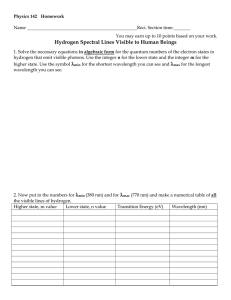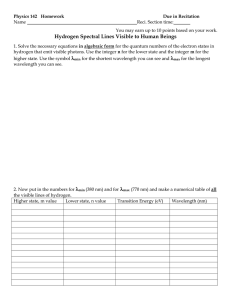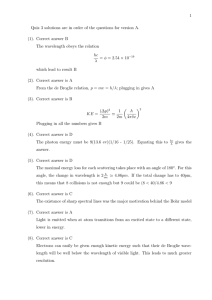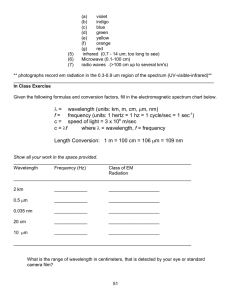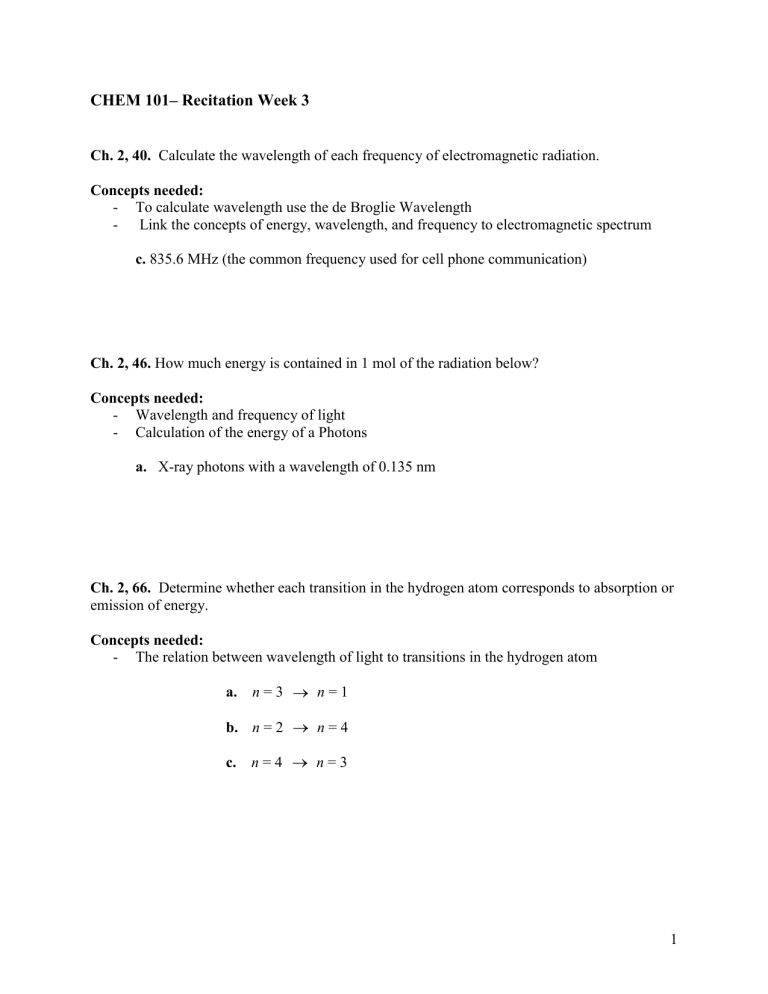
CHEM 101– Recitation Week 3 Ch. 2, 40. Calculate the wavelength of each frequency of electromagnetic radiation. Concepts needed: - To calculate wavelength use the de Broglie Wavelength - Link the concepts of energy, wavelength, and frequency to electromagnetic spectrum c. 835.6 MHz (the common frequency used for cell phone communication) Ch. 2, 46. How much energy is contained in 1 mol of the radiation below? Concepts needed: - Wavelength and frequency of light - Calculation of the energy of a Photons a. X-ray photons with a wavelength of 0.135 nm Ch. 2, 66. Determine whether each transition in the hydrogen atom corresponds to absorption or emission of energy. Concepts needed: - The relation between wavelength of light to transitions in the hydrogen atom a. n=3 n=1 b. n = 2 n = 4 c. n=4 n=3 1 Ch. 2, 71. An electron in the n = 7 level of the hydrogen atom relaxes to a lower energy level, emitting light of 397 nm. What is the value of n for the level to which the electron relaxed? Concepts needed: - Relation between Quantum numbers to their corresponding orbitals and each other - Correlate the concepts of the wavelength of light to transitions in the hydrogen atom Ch. 2, 73. Ultraviolet radiation and radiation of shorter wavelengths can damage biological molecules because they carry enough energy to break bonds within the molecules. A typical carbon-carbon bond requires 348 kJ/mol to break. What is the longest wavelength of radiation with enough energy to break carbon-carbon bonds? Concepts needed: - The concept of the de Broglie Wavelength - Define carbon-carbon bond Ch. 2, 98. Water is exposed to infrared radiation of wavelength 2.8 x 10-4 cm. Assume that all radiation is absorbed and converted to heat. How many photons are required for the sample to absorb 16.72 J of heat? Concepts needed: - The concept of the de Broglie Wavelength - Calculation of the energy of a photon Ch. 2, 104. The light emitted from one of the following electronic transitions ( n = 4 n = 3 or n = 3 n = 2) in the hydrogen atom causes the photoelectric effect in a particular metal, while light from the other transition does not. Without doing any calculations, which transition causes the photoelectric effect and why? Concepts needed: - The relation between quantum numbers to each other and their related orbitals - Define molecular electronic transitions 2 Ch. 2, 106. Without doing any calculations, which transition in the hydrogen atom results in emitted light with the longest wavelength? Concepts needed: - The relation between quantum numbers to each other and their related orbitals - Correlate the concepts of the wavelength of light to transitions in the hydrogen atom a. n = 4 n = 3 b. n = 2 n = 1 c. n = 3 n = 2 Honors only Ch. 2, 44. A heat lamp produces 32.8 watts of power at a wavelength of 6.5 μm. How many photons are emitted per second? (1 watt = 1 J/s) 3
